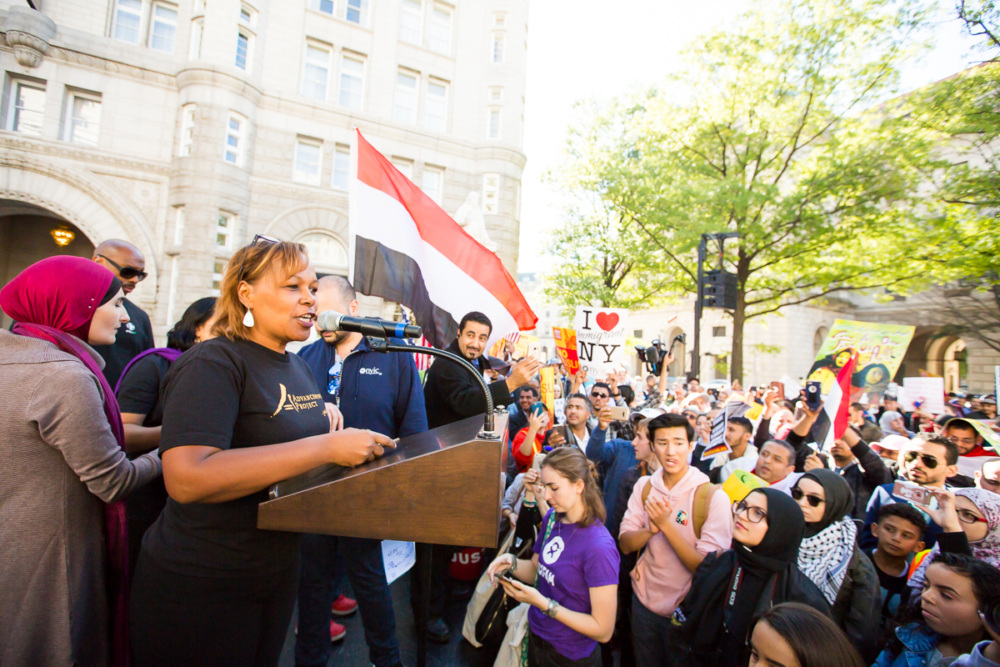On civil rights, we must reimagine freedom after Trump
November 16, 2017

November 16, 2017
(Photo Credit: Les Talusan)
“It is like torture,” said Felipa de la Cruz — and one can hardly blame her. Her daughter, Rosa Maria, a 10-year-old with cerebral palsy, was intercepted by immigration authorities as she rode in an ambulance on her way to surgery. For days, the child was held in a Texas detention center for minors. Rosa Maria’s story embodies the depths to which the current administration has redefined American-ness and freedom.
One year after the election, the Trump administration has wielded the power of the United States presidency into a sharpened attack on people of color, sick children and unassuming adults alike. In the process, our government has narrowed the definition of freedom into one that further benefits the corporate sector and those who are male, white, and gender-conforming. That excludes people like Rosa Maria, and countless others who have been killed, attacked, silenced or erased under this regime.
The results have been, simply put, painful and devastating. Any attempt to list the concrete ways in which the Trump administration is putting communities of color under attack stretches the limits of patience, journalistic documentation, and newspaper space.
Under ordinary times, this mother’s torment would gain unfettered sympathy and wide support. But following Election Day 2016, we continue to realize we are no longer living in ordinary times, and liberty looks a lot different. Brown-skinned, female, handicapped, and unrecognized as a citizen, young Rosa Maria is far from what our system — and this administration — deems worthy of being free in this country.
Racism, of course, did not start with Donald Trump. But the racism that began in this country as genocide and slavery before the Declaration of Independence was signed still casts a long shadow into the present.
What is not new is the historical patterns around racism in America. Backlash against people of color often comes directly in the midst of moderate racial progress — whenever there are modest policy changes, gains in political power, and increased visibility of typically-excluded communities. Our history is studded with crackdowns from the white majority hurting people of color following these advancements.
One such instance epitomizes the intersection of a scared, racist white populace pitting themselves against an obstinate effort for racial progress. At the center of it was President James Buchanan and the fight for freedom for enslaved Black people.
On the eve of Buchanan’s inauguration in 1856, as the abolitionist movement reached fever pitch, one important racial matter hung over the president-elect’s head: the Dred Scott v. Sandford case. The court was to decide the mammoth question of whether Black people, even Blacks in free states, were considered citizens of the United States.
Citizenship in this context, to be clear, does not simply mean whether a person should live in the United States or move to another country. Rather, it meant whether they — or we, Blacks — were recognized as people.
The ‘racial anxiety’ of the pro-slavery side won after pressure from from President Buchanan to make the issue of freedom go away. With a strike of the gavel and the president’s nod of approval, Blacks were seen as less-than-human by the judicial system once more.
As the justices euphemistically put it, Black people were not part of “the political community formed and brought into existence by the Constitution.” Blacks, the court ruled, were not actually people. They were property.
Despite having fought a civil war, America remains built on the wrong foundation. The house we’ve built rests on bedrock of white supremacy. The question here is to what degree we will move away from this. To the point that we are fighting for incremental gains, we are still on the same path set by framers, judges, and governments — an entire country — that refused to acknowledge humanity of people of color.
The year since the election has been challenging. But like another point in our history where we were almost broken by our own racism, this moment also presents us with a once-in-a-lifetime opportunity to reimagine and rebuild.
For those of us who believe that out of true struggle comes victory, we understand that even during this regime — yes, even as we are being erased, silenced, and killed — we are not strictly in a time of doom. Rather, we could be closer than ever to an era of modern emancipation.
How we pursue the future after Trump must not be reduced to one more political battle. Instead of seeing civic engagement as an extension of the political day-to-day, or expecting a more equitable outcome without a hard look at ourselves, we must be united in our commitment to reinventing freedom for all. That means getting serious about political and civic participation and welcoming new conversations.
It starts by taking account of who we are and what this country truly is. By looking at our history – our complete history – we’ll see times during which the Republic has been imperiled because of this country’s racism and presidents who tipped the scales in its favor. The answers today, as they were in times past, are there for us to study. The answers lie within the voices of those who against all odds have survived genocide, slavery, and the racist terrorism woven into our history.
We are perilously close to a time when the very foundation of this country nearly finished us, but we can re-learn important lessons from past struggles for freedom. If we take to heart the full lessons of our ancestors and history books, we will not only be enraged and heartbroken when we hear about another Rosa Maria. We will also be propelled and equipped to respond, protest and enact the justice and freedom we’ve been waiting for.